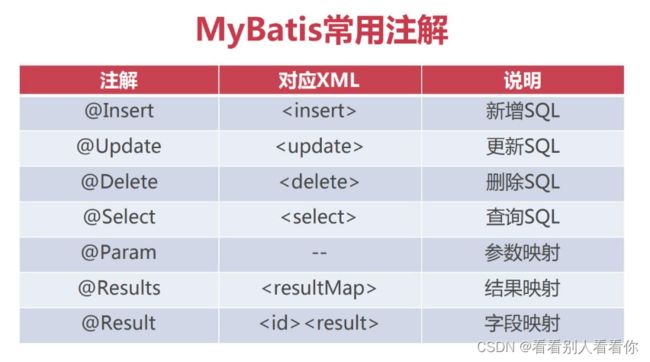MyBatis进阶(二)
目录
OneToMany对象关联查询
ManyToOne对象关联查询
PageHelper分页插件
MyBatis整合C3P0连接池
MyBatis批处理
Mybatis注解开发方式
Goods:
package com.imooc.mybatis.entity;
import java.util.List;
public class Goods {
private Integer goodsId;//商品编号
private String title;//标题
private String subTitle;//子标题
private Float originalCost;//原始价格
private Float currentPrice;//当前价格
private Float discount;//折扣率
private Integer isFreeDelivery;//是否包邮 ,1-包邮 0-不包邮
private Integer categoryId;//分类编号
private List goodsDetails;
public Integer getGoodsId() {
return goodsId;
}
public void setGoodsId(Integer goodsId) {
this.goodsId = goodsId;
}
public String getTitle() {
return title;
}
public void setTitle(String title) {
this.title = title;
}
public String getSubTitle() {
return subTitle;
}
public void setSubTitle(String subTitle) {
this.subTitle = subTitle;
}
public Float getOriginalCost() {
return originalCost;
}
public void setOriginalCost(Float originalCost) {
this.originalCost = originalCost;
}
public Float getCurrentPrice() {
return currentPrice;
}
public void setCurrentPrice(Float currentPrice) {
this.currentPrice = currentPrice;
}
public Float getDiscount() {
return discount;
}
public void setDiscount(Float discount) {
this.discount = discount;
}
public Integer getIsFreeDelivery() {
return isFreeDelivery;
}
public void setIsFreeDelivery(Integer isFreeDelivery) {
this.isFreeDelivery = isFreeDelivery;
}
public Integer getCategoryId() {
return categoryId;
}
public void setCategoryId(Integer categoryId) {
this.categoryId = categoryId;
}
public List getGoodsDetails() {
return goodsDetails;
}
public void setGoodsDetails(List goodsDetails) {
this.goodsDetails = goodsDetails;
}
}
GoodsDetail:
package com.imooc.mybatis.entity;
public class GoodsDetail {
private Integer gdId;
private Integer goodsId;
private String gdPicUrl;
private Integer gdOrder;
private Goods goods;
public Integer getGdId() {
return gdId;
}
public void setGdId(Integer gdId) {
this.gdId = gdId;
}
public Integer getGoodsId() {
return goodsId;
}
public void setGoodsId(Integer goodsId) {
this.goodsId = goodsId;
}
public String getGdPicUrl() {
return gdPicUrl;
}
public void setGdPicUrl(String gdPicUrl) {
this.gdPicUrl = gdPicUrl;
}
public Integer getGdOrder() {
return gdOrder;
}
public void setGdOrder(Integer gdOrder) {
this.gdOrder = gdOrder;
}
public Goods getGoods() {
return goods;
}
public void setGoods(Goods goods) {
this.goods = goods;
}
}
OneToMany对象关联查询
Goods(一) --> GoodsDetail(多)
在Goods(一)中增加属性: private List
- resultMap可用于说明一对多或者多对一的映射逻辑
- id 是resultMap属性引用的标志
- type 指向One的实体(Goods)
goods.xml
collection的含义是,在 “select * from t_goods limit 0,1 ”得到结果后,对所有Goods对象遍历得到goods_id字段值,并代入到goodsDetail命名空间的findByGoodsId的SQL中执行查询,将得到的"商品详情"集合赋值给goodsDetails List对象。
goods_detail.xml
/**
* 一对多对象关联查询
* @throws Exception
*/
@Test
public void testOneToMany() throws Exception {
SqlSession session = null;
try {
session = MyBatisUtils.openSession();
List list = session.selectList("goods.selectOneToMany");
for(Goods goods:list) {
System.out.println(goods.getTitle() + ":" + goods.getGoodsDetails().size());
}
} catch (Exception e) {
throw e;
} finally {
MyBatisUtils.closeSession(session);
}
} ManyToOne对象关联查询
GoodsDetail(多) --> Goods(一)
在GoodsDetail(多)中增加属性: private Goods goods;
goods_detail.xml
goods.xml
/**
* 测试多对一对象关联映射
*/
@Test
public void testManyToOne() throws Exception {
SqlSession session = null;
try {
session = MyBatisUtils.openSession();
List list = session.selectList("goodsDetail.selectManyToOne");
for(GoodsDetail gd:list) {
// gd.getGoods()为goods对象
System.out.println(gd.getGdPicUrl() + ":" + gd.getGoods().getTitle());
}
} catch (Exception e) {
throw e;
} finally {
MyBatisUtils.closeSession(session);
}
} PageHelper分页插件
使用流程
maven引入PageHelper与jsqlparser
com.github.pagehelper
pagehelper
5.1.10
com.github.jsqlparser
jsqlparser
2.0
mybatis-config.xml增加Plugin配置
代码中使用PageHelper.startPage()自动分页
goods.xml
/**
* PageHelper分页查询
*/
@Test
public void testSelectPage() throws Exception {
SqlSession session = null;
try {
session = MyBatisUtils.openSession();
/*startPage方法会自动将下一次查询进行分页*/
PageHelper.startPage(2,10); //参数1:第几页 参数2:每页几行
Page page = (Page) session.selectList("goods.selectPage");
System.out.println("总页数:" + page.getPages());
System.out.println("总记录数:" + page.getTotal());
System.out.println("开始行号:" + page.getStartRow());
System.out.println("结束行号:" + page.getEndRow());
System.out.println("当前页码:" + page.getPageNum());
List data = page.getResult();//当前页数据
for (Goods g : data) {
System.out.println(g.getTitle());
}
System.out.println("");
} catch (Exception e) {
throw e;
} finally {
MyBatisUtils.closeSession(session);
}
} 详细使用:如何使用分页插件 (pagehelper.github.io)
MyBatis整合C3P0连接池
引入依赖
com.mchange
c3p0
0.9.5.4
数据源工厂类:
import com.mchange.v2.c3p0.ComboPooledDataSource;
import org.apache.ibatis.datasource.unpooled.UnpooledDataSourceFactory;
/**
* C3P0与MyBatis兼容使用的数据源工厂类
*/
public class C3P0DataSourceFactory extends UnpooledDataSourceFactory {
public C3P0DataSourceFactory(){
this.dataSource = new ComboPooledDataSource();
}
}C3P0作为连接池,假如要让MyBatis对他进行支持的话,需要额外的扩展一个类,需要创建一个全新的包,名为DataSource,用于保存数据源,在这里创建一个新的类,类名为C3P0DataSourceFactory,创建完成之后必须要继承一个父类,名为UnpooledDataSourceFactory,并且增加一个构造函数,含义是在这个类初始化的时候。让数据员源由c3p0进行创建。
在mybatis-config.xml当中,将
MyBatis批处理
当传进来的参数为list时,需用到foreach标签
批量增加和删除:
INSERT INTO t_goods(title, sub_title, original_cost, current_price, discount, is_free_delivery, category_id)
VALUES
(#{item.title},#{item.subTitle}, #{item.originalCost}, #{item.currentPrice}, #{item.discount}, #{item.isFreeDelivery}, #{item.categoryId})
DELETE FROM t_goods WHERE goods_id in
#{item}
Mybatis注解开发方式
采用注解开发是不用编写mapper.xml文件的,取而代之需要创建一个名为dao的包,在这个包中创建一系列的接口,利用接口加注解替代原有的xml文件。
配置文件中进行包扫描:
查询:
public interface GoodsDAO {
@Select("select * from t_goods where current_price between #{min} and #{max} order by current_price limit 0,#{limt}")
public List selectByPriceRange(@Param("min") Float min ,@Param("max") Float max ,@Param("limt") Integer limt);
}
session会根据GoodsDAO里的配置信息来动态地生成GoodsDAO的实现类,也就是说这里不用额外的开发直接利用goodsDAO里的方法进行相应的增删改查即可。
@Test
public void testSelectByPriceRange() throws Exception {
SqlSession session = null;
try{
session = MyBatisUtils.openSession();
GoodsDAO goodsDAO = session.getMapper(GoodsDAO.class);//得到映射器,传入类对象
List list = goodsDAO.selectByPriceRange(100f, 500f, 20);
System.out.println(list.size());
}catch (Exception e){
throw e;
} finally {
MyBatisUtils.closeSession(session);
}
} 添加:
public interface GoodsDAO {
@Insert("INSERT INTO t_goods(title, sub_title, original_cost, current_price, discount, is_free_delivery, category_id)" +
" VALUES (#{title} , #{subTitle} , #{originalCost}, #{currentPrice}, #{discount}, #{isFreeDelivery}, #{categoryId})")
// 获取新插入的自增主键的编号
@SelectKey(statement = "select last_insert_id()" , before = false , keyProperty = "goodsId" , resultType = Integer.class)
public int insert(Goods goods);
} 测试类:
/**
* 新增数据
* @throws Exception
*/
@Test
public void testInsert() throws Exception {
SqlSession session = null;
try{
session = MyBatisUtils.openSession();
Goods goods = new Goods();
goods.setTitle("测试商品");
goods.setSubTitle("测试子标题");
goods.setOriginalCost(200f);
goods.setCurrentPrice(100f);
goods.setDiscount(0.5f);
goods.setIsFreeDelivery(1);
goods.setCategoryId(43);
GoodsDAO goodsDAO = session.getMapper(GoodsDAO.class);
//insert()方法返回值代表本次成功插入的记录总数
int num = goodsDAO.insert(goods);
session.commit();//提交事务数据
System.out.println(goods.getGoodsId());
}catch (Exception e){
if(session != null){
session.rollback();//回滚事务
}
throw e;
}finally {
MyBatisUtils.closeSession(session);
}
}实现结果映射:
public interface GoodsDAO {
@Select("select * from t_goods")
//
@Results({
//
@Result(column = "goods_id" ,property = "goodsId" , id = true) ,
//
@Result(column = "title" ,property = "title"),
@Result(column = "current_price" ,property = "currentPrice")
})
public List selectAll();
} 测试类:
@Test
public void testSelectAll() throws Exception {
SqlSession session = null;
try{
session = MyBatisUtils.openSession();
GoodsDAO goodsDAO = session.getMapper(GoodsDAO.class);
List list = goodsDAO.selectAll();
System.out.println(list.size());
}catch (Exception e){
throw e;
} finally {
MyBatisUtils.closeSession(session);
}
} 